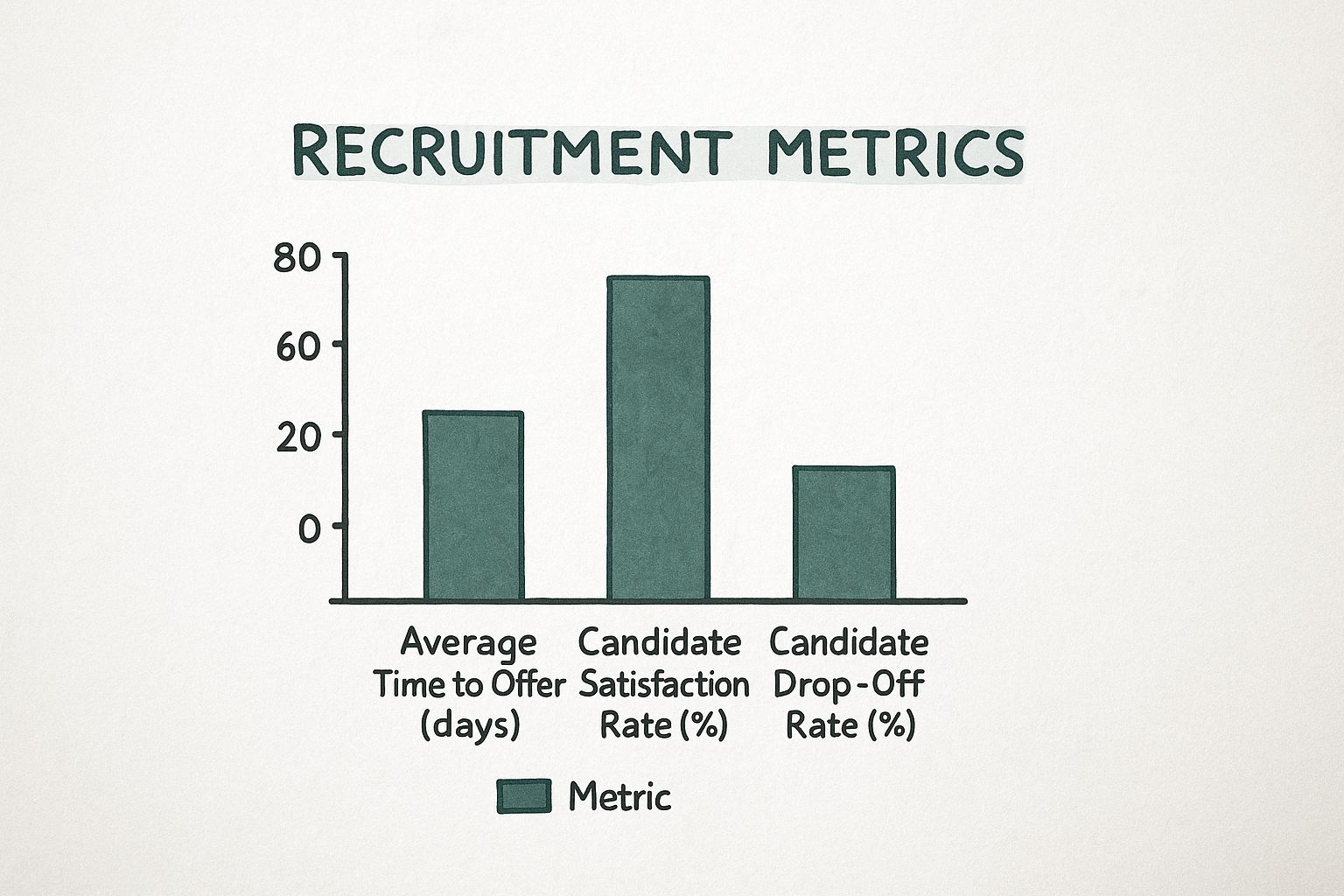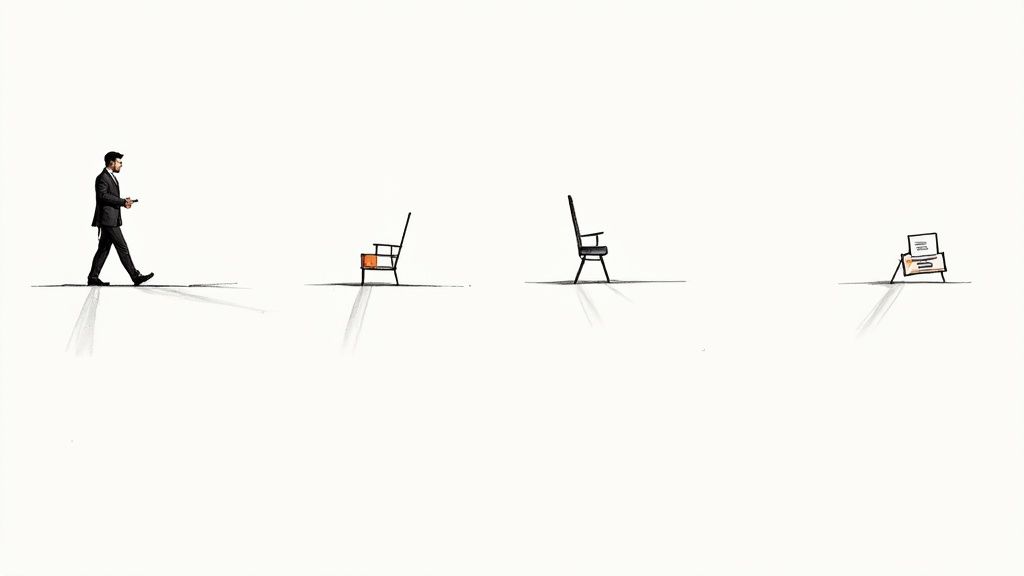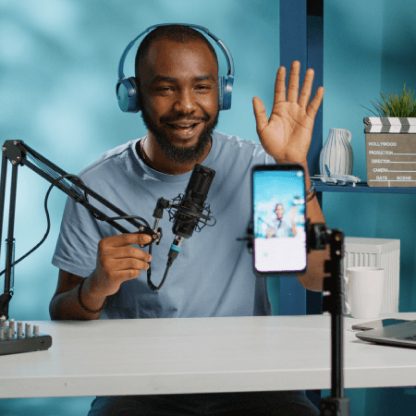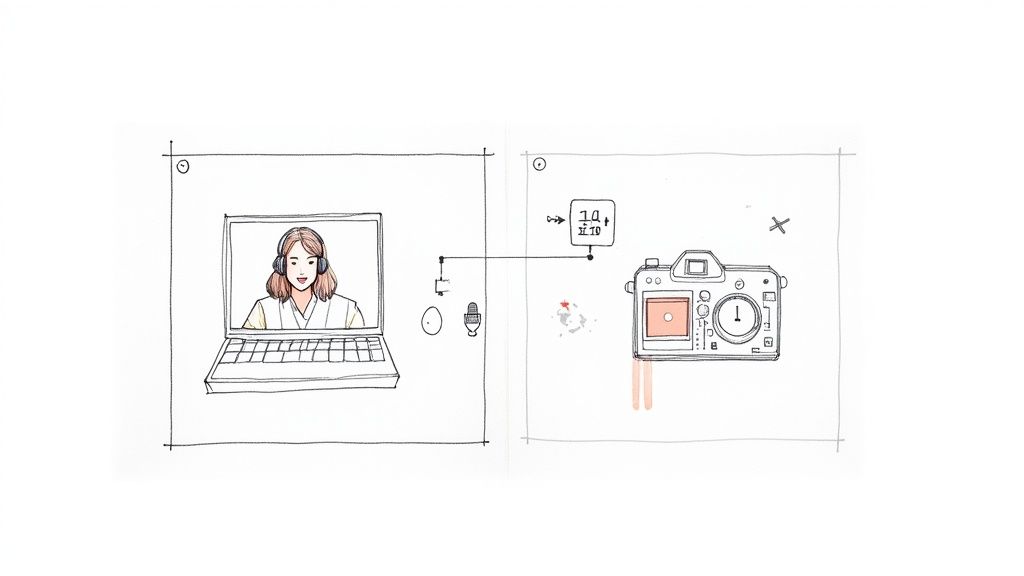To truly improve your candidate experience, you have to move beyond thinking of hiring as a simple transaction. It’s a human-centric journey. This means clear communication, transparent timelines, and an application process that respects every single person's time and effort—whether they get the job or not.
Why Your Candidate Experience Matters More Than Ever
Let's be real—a bad hiring process doesn't just lose you a candidate. It can lose you customers and, worse, tarnish your entire brand reputation. The way you treat applicants is a direct reflection of your company's values, and in today's market, top talent has plenty of options.
A frustrating journey marked by vague job descriptions, ghosting, or disorganized interviews will send the best people running straight to your competitors. This isn't just an HR problem; it's a business-critical issue with very real consequences.
The Real-World Impact of a Poor Experience
Every interaction a candidate has with your company—from the first click on a job ad to the final rejection email—shapes their perception. One negative touchpoint can completely undo all your hard work in recruitment marketing.
The data backs this up. A staggering 50% of candidates say they would stop buying from a company after a bad application experience, drawing a direct line from your hiring practices to your bottom line. With over half of job seekers actively avoiding companies with poor employer reviews, the link between candidate experience and brand health is crystal clear.
A candidate’s journey is your company’s story in miniature. A respectful process turns every applicant, hired or not, into a potential brand advocate. A dismissive one creates detractors who will gladly share their story online.
This infographic breaks down key metrics like time-to-offer and satisfaction rates, showing where the common friction points pop up in the hiring cycle.

As you can see, longer hiring timelines almost always correlate with lower candidate satisfaction and higher drop-off rates. Speed and efficiency aren't just nice-to-haves; they're essential.
Key Candidate Journey Touchpoints and Their Business Impact
Understanding how each stage of the hiring process affects your business is the first step toward making meaningful improvements. The table below breaks down these critical touchpoints, showing how a positive experience can be a magnet for talent, while a negative one creates serious risks.
| Hiring Stage | Positive Experience Outcome | Negative Experience Consequence |
|---|---|---|
| Job Discovery & Application | Attracts a wider, more qualified pool of diverse applicants. | High drop-off rates; top candidates abandon complex applications. |
| Communication & Updates | Builds trust and keeps candidates engaged, even if they aren't selected. | Candidates feel disrespected ("ghosted"), leading to negative reviews. |
| Interview Process | Showcases a professional, organized, and respectful company culture. | Creates brand detractors who share poor experiences with their network. |
| Offer or Rejection | Turns all applicants into brand advocates, regardless of the outcome. | Damages consumer loyalty; 50% of candidates may boycott products. |
| Post-Hiring | Reinforces the decision to join, boosting new-hire morale and retention. | Taints employer brand, making it harder and more expensive to hire in the future. |
Ultimately, a well-managed candidate journey isn't just about courtesy—it's a strategic business function that protects your brand, attracts better talent, and directly impacts your revenue.
Building a Competitive Advantage Through Empathy
At the end of the day, a great candidate experience is about more than just filling a role. It’s about building relationships and showing genuine respect. The companies that consistently win the war for talent are the ones that treat every single applicant with dignity.
For a deep dive into building a candidate-centric hiring journey, explore these effective strategies to improve candidate experience. By prioritizing an intentional, empathetic process, you're not just hiring—you're building a powerful competitive advantage that pays dividends long after the position is filled.
Design a Respectful and Seamless Application Process

Let's be honest—your application form is the very first real interaction a candidate has with your company. It sets the stage for everything else. If it's clunky, confusing, or just plain long, you’re not just frustrating potential hires. You’re sending a clear signal that you don't respect their time, which can sour their view of your brand before they even finish.
On the flip side, a smooth and respectful application process is a huge competitive advantage. Time and again, research shows that overly complicated forms are the top reason candidates bail. Every single redundant field or unnecessary click is a chance for top talent to drop off and apply to a competitor who gets it right. The mission is simple: make it as painless as possible for qualified people to say, "I'm interested."
Start with Transparency in Your Job Descriptions
Before a candidate even thinks about clicking "apply," they're dissecting your job description. A lack of clarity here is an immediate red flag for any savvy job seeker. To build trust from the get-go, your descriptions need to be direct, inclusive, and completely transparent.
Here's how to do it:
- Be Explicit About Salary: This isn't a "nice-to-have" anymore; it's a baseline expectation. Posting a salary range shows you respect a candidate's time and prevents you both from wasting it on mismatched expectations down the line.
- Define the Work Model: Is the role fully remote, hybrid, or on-site? If it’s hybrid, don't be vague—spell out the in-office days or requirements. Ambiguity just leads to frustration.
- Outline the Process: A quick note about the number of interview stages can make a world of difference. When candidates know what to expect, it reduces their anxiety and helps them plan their time accordingly.
Streamline the Application Itself
Once you've nailed the transparent job description, the application form has to deliver on that promise of efficiency. Let's face it, nobody wants to re-enter their entire work history when it's already on their résumé. High drop-off rates are almost always tied to lengthy, redundant forms. Your goal should be to hunt down and eliminate every point of friction.
A candidate's willingness to complete an application is a direct measure of its simplicity. If your form takes more than five minutes, you're likely losing great people who value their time.
Consider these simple but game-changing fixes:
- Enable ‘Apply with LinkedIn’ or ‘Apply with Indeed’: These integrations are non-negotiable. They let candidates auto-fill their info in seconds, which drastically cuts down on tedious manual entry.
- Make It Mobile-First: Most candidates are job hunting on their phones. Your application must be easy to navigate and complete on a small screen. No exceptions.
- Cut Redundant Fields: If you're asking for a résumé upload, don't immediately ask for a full work history. You can always gather more details later from the candidates you decide to move forward with.
Making these changes shows your company is modern, efficient, and—most importantly—respects people's time. This approach also pairs perfectly with tools for automated candidate screening, freeing up your team to focus on the awesome applicants who had a great first experience. An effortless application isn't just about boosting completion rates; it's a strategic first step in building goodwill.
Master The Art of Proactive Communication and Feedback

If there's one place where a great candidate experience goes to die, it's the communication black hole. We've all been there: you pour your heart into an application, hit submit, and then… crickets. This is hands-down the biggest frustration for job seekers.
That silence doesn't just feel disrespectful; it actively hurts your employer brand. When candidates have a bad experience, they talk. And if they don't hear anything from you within a week, 34% will just assume they've been ghosted. It sends a pretty loud message that you don't value their time or interest.
To really fix this, you have to get proactive and transparent with your communication at every single stage. This isn't just about being polite. It's about building trust and turning every single person who applies—even the ones you don't hire—into a fan.
Set Clear Expectations From Day One
Your first move should be to set a clear timeline and actually stick to it. From the second someone applies, they should have a rough idea of what to expect and when. This one simple action can dramatically cut down on candidate anxiety and stop them from dropping out of your process.
Just include a quick overview of your hiring process right in the job description or on your careers page. A simple timeline could be:
- Application Review: 1-2 weeks
- First Interview: 2-3 weeks from application deadline
- Final Round: 4 weeks from application deadline
- Decision: Within 5 weeks
And if things get delayed? Just send a quick, honest update. It shows respect and keeps your best candidates from losing interest.
Humanize Your Automated Messages
Automation is a recruiter's best friend, but only if you use it right. Generic, robotic emails can feel just as cold as total silence. The trick is to inject some personality and a human touch into your automated replies so candidates feel seen from the get-go.
Instead of a bland "Application Received" notification, why not try something a bit more personal and helpful?
Pro Tip: Your first automated email is a golden opportunity. Use it to make a great impression. You could include a link to your company values page, a short video from the team, or an FAQ about your hiring process. It's a small effort that turns a boring transactional email into a genuinely engaging experience.
For instance, your confirmation email can thank the candidate by name, confirm the role they applied for, and quickly outline the next steps and timeline again. It's an efficient way to keep that personal connection that makes all the difference. For more ideas on keeping applicants invested, check out these fresh candidate engagement strategies for 2025.
Deliver Rejection with Respect
Nobody enjoys being the bearer of bad news, but how you handle rejections says a lot about your company's character. Ghosting candidates who didn't make the cut is a surefire way to create brand detractors. On the flip side, a respectful rejection can leave a surprisingly positive and lasting impression.
Giving personalized feedback to every single applicant isn't always realistic, I get it. But you should always provide closure. For anyone who invested their time in an interview, a personalized email or a quick phone call is a powerful gesture. For everyone else, a well-written, empathetic template is infinitely better than silence.
This simple act of following up shows integrity and improves your candidate experience, even for those who weren't the right fit this time around.
Conducting Interviews That Feel Like a Conversation
The interview is often the most high-stakes, make-or-break moment in the entire hiring process. It's where a candidate’s perception of your company solidifies, for better or worse.
An interview that feels like an interrogation or a one-sided grilling session can undo all the positive groundwork you’ve laid. The goal here is to completely shift the dynamic from a rigid evaluation to a genuine, two-way conversation.
This requires training your hiring managers to be more than just assessors; they need to become true brand ambassadors. They should show up prepared, be punctual, and focus on discovering a candidate’s potential rather than just ticking boxes on a scorecard. When an interview is a respectful, engaging dialogue, candidates feel comfortable enough to showcase their best work. More importantly, they get a real sense of your company culture.
Humanizing the Interview Process
The single biggest mistake companies make is treating interviews as a test of nerves. Instead, think of it as a mutual discovery process. You're both trying to figure out if this is the right long-term fit. A human-centric approach makes candidates feel valued and respected, regardless of the outcome.
To get there, you need to create an environment of psychological safety. Start the conversation with some light, genuine rapport-building. Clearly explain the agenda for the meeting, and actively encourage them to ask questions throughout. Remember, you’re not just gathering information—you’re building a relationship.
This positive interaction has a huge impact. A 2025 report reveals that a staggering 66% of job applicants accepted an offer specifically because of a great candidate experience. On the flip side, 36% of candidates rejected offers due to negative interview experiences, showing just how critical this stage is. You can learn more about how recruiting practices influence these decisions from these detailed industry statistics.
Choosing the Right Interview Format
Different roles call for different interview styles, but the preference for genuine human interaction is universal. While technology can help streamline parts of the process, it should never replace the core human connection that defines a great interview.
-
Live Video Interviews: This has become the standard for most remote and hybrid roles. It offers the face-to-face connection of an in-person meeting with the added convenience for everyone involved. Just make sure your team is trained on video etiquette—good lighting, a professional background, and minimal distractions are non-negotiable.
-
Phone Screens: Perfect for those initial conversations. Keep them focused and relatively brief (think 20-30 minutes). The goal is simply to confirm core qualifications and initial alignment, setting the stage for deeper conversations later on.
-
One-Way Video Interviews: Use these with extreme caution. I know they seem efficient for high-volume roles, but many candidates find them impersonal and incredibly stressful. If you absolutely must use them, be transparent about why and provide crystal-clear instructions. For candidates preparing for this format, our guide on mastering your on-demand video interview is a great resource.
The best interviews feel like a peek into what it’s actually like to work at your company. If your interview is rigid, scripted, and formal, candidates will assume your culture is too. If it's collaborative and engaging, they'll picture themselves thriving on your team.
Ultimately, a positive interview experience is one of your most powerful tools. It reinforces a candidate's interest and makes your job offer that much more compelling when it finally arrives.
Using Technology to Enhance Human Connection

There's a common fear that hiring technology creates distance, turning a deeply human process into something cold and robotic. I get it. But when you use it the right way, technology should do the exact opposite.
The real goal is to get the tedious, repetitive tasks off your plate. Think about all the time wasted on scheduling and manual updates. Tech should handle that, freeing up recruiters to focus on what actually matters—building genuine connections with candidates.
It’s not about replacing human interaction. It’s about supporting and scaling it. The right tools can make your hiring process more efficient and respectful, which is the secret to a standout candidate experience. It’s about making technology work for people, not the other way around.
Personalize the Digital Journey
Your career site is often a candidate's first real look at your company, but most offer a generic, one-size-fits-all experience. This is a massive missed opportunity. Modern tools can tailor this journey from the very first click, making candidates feel seen and understood.
For instance, an intelligent career site can:
- Recommend Relevant Jobs: Instead of making someone sift through endless listings, the site can analyze their resume or LinkedIn profile to immediately surface roles that are a perfect match.
- Showcase Personalized Content: It can display team testimonials or blog posts related to a candidate’s field, giving them a glimpse into the parts of your culture they actually care about.
- Guide Them with Chatbots: A well-programmed chatbot can answer common questions about benefits or your hiring process 24/7, offering instant support and improving their experience.
Despite what's possible, a recent report found that 88% of Fortune 500 companies failed to suggest relevant jobs based on a candidate’s skills. An even more striking 83% lacked chatbots that could even recommend roles. This is a huge gap between what’s possible and what’s actually being practiced.
True personalization isn’t just about putting a candidate's first name in an email. It’s about anticipating their needs and serving up relevant information at the exact moment they need it, creating a seamless and supportive journey.
Automate Tasks Not Relationships
An Applicant Tracking System (ATS) can be your best friend in building human connection—if you set it up right. Its entire purpose is to lift the administrative weight from your team’s shoulders so they can spend less time on paperwork and more time talking to people.
A well-oiled ATS should be handling things like:
- Application Acknowledgments: Sending instant, personalized confirmation emails so candidates know their application didn't disappear into a black hole.
- Status Updates: Automatically notifying candidates when they move to the next stage or if a decision has been made.
- Internal Scheduling: Coordinating interviewer availability without the endless email chains.
When your tech handles these logistics, your recruiters are free to conduct more thoughtful interviews, provide meaningful feedback, and build real relationships with top contenders. This is becoming even more critical with the rise of AI recruitment agencies that are changing how we find talent.
Ultimately, the best technology makes the human parts of recruiting easier, not obsolete.
Of course. Here is the rewritten section, crafted to sound like an experienced human expert and match the provided examples.
Common Questions About Improving Candidate Experience
Even when you have the best intentions, improving your candidate experience can feel like a huge, complicated project. Let's cut through the noise and tackle some of the most common questions hiring teams wrestle with when trying to build a more respectful and effective process.
How Can Small Businesses Improve Candidate Experience?
You don't need a huge budget to make a massive difference. For small businesses, it’s all about nailing the fundamentals—the things that cost you little more than your time and attention.
Get obsessive about clear, consistent communication. This means writing job descriptions that are actually transparent, including salary ranges, and setting realistic timeline expectations right from the start. Make sure every single interview is organized, starts on time, and feels like a genuine two-way conversation, not an interrogation.
But honestly, the most powerful, low-cost thing you can do is give closure to every single applicant. A simple, kind, templated rejection email is infinitely better than ghosting them. This one action builds an incredible amount of goodwill and a powerful employer brand.
What Is the Most Impactful Change to Make Today?
If you can only do one thing, make a communication guarantee. Think of it as a simple, public promise you make to every single person who applies.
Vow to acknowledge every application you receive within 48 business hours. Then, commit to giving every candidate who actually interviews a final status update, no matter the outcome.
This single policy hits the number one frustration for job seekers head-on: being left in the dark. It shows you respect their time and effort, instantly setting you apart from the competition who can't be bothered to follow up. It’s a complete game-changer for your company’s reputation.
Are One-Way Video Interviews a Good Idea?
This is a tricky one, and the honest answer is: it depends, but you should be cautious. While they seem efficient on paper, one-way or asynchronous video interviews are widely disliked by candidates. They often feel impersonal, high-stress, and frankly, a bit weird, preventing you from building any real rapport.
For that reason, I'd say avoid them for most roles. A quick, live conversation over the phone or a video call almost always creates a much better, more human experience for everyone involved.
But, if you absolutely must use them for extremely high-volume, entry-level positions, please do it right:
- Be upfront with candidates about why you’re using this format.
- Give them clear, detailed instructions and tips for success.
- Keep the number of questions and the total time commitment as short as possible.
How Do We Get Honest Feedback on Our Hiring Process?
The only way to find your blind spots is to ask the people who just went through your process. The trick is making it easy and safe for them to tell you the truth.
Send a brief, anonymous survey to candidates after the process is over. And it's crucial to send this to both hired and rejected applicants—otherwise, you’re only getting half the story.
Keep the survey short and sweet. No more than 3-5 targeted questions about the application, the clarity of your communication, and the interview stages. Making it optional and guaranteeing it's anonymous will skyrocket your response rates. This direct feedback is gold; it will show you specific pain points you’d never see from the inside.
Ready to stop losing top talent to a slow, impersonal screening process? Async Interview automates the tedious parts of hiring, like initial screenings and scheduling, so you can focus on building relationships with the best candidates. Our platform helps companies hire up to ten times faster while ensuring every applicant has a professional and respectful experience. Start your free trial today and see the difference.




